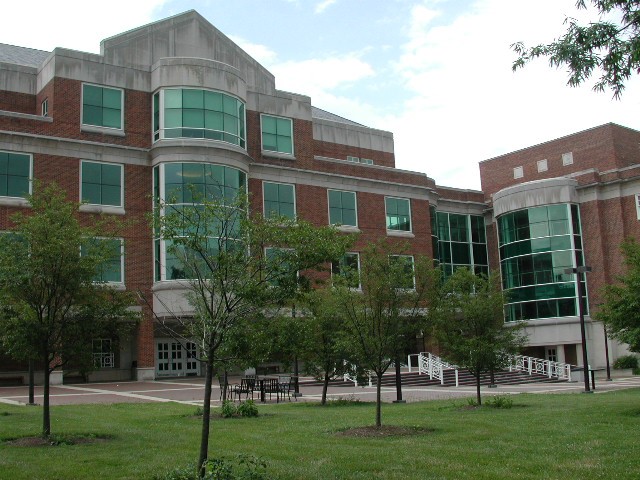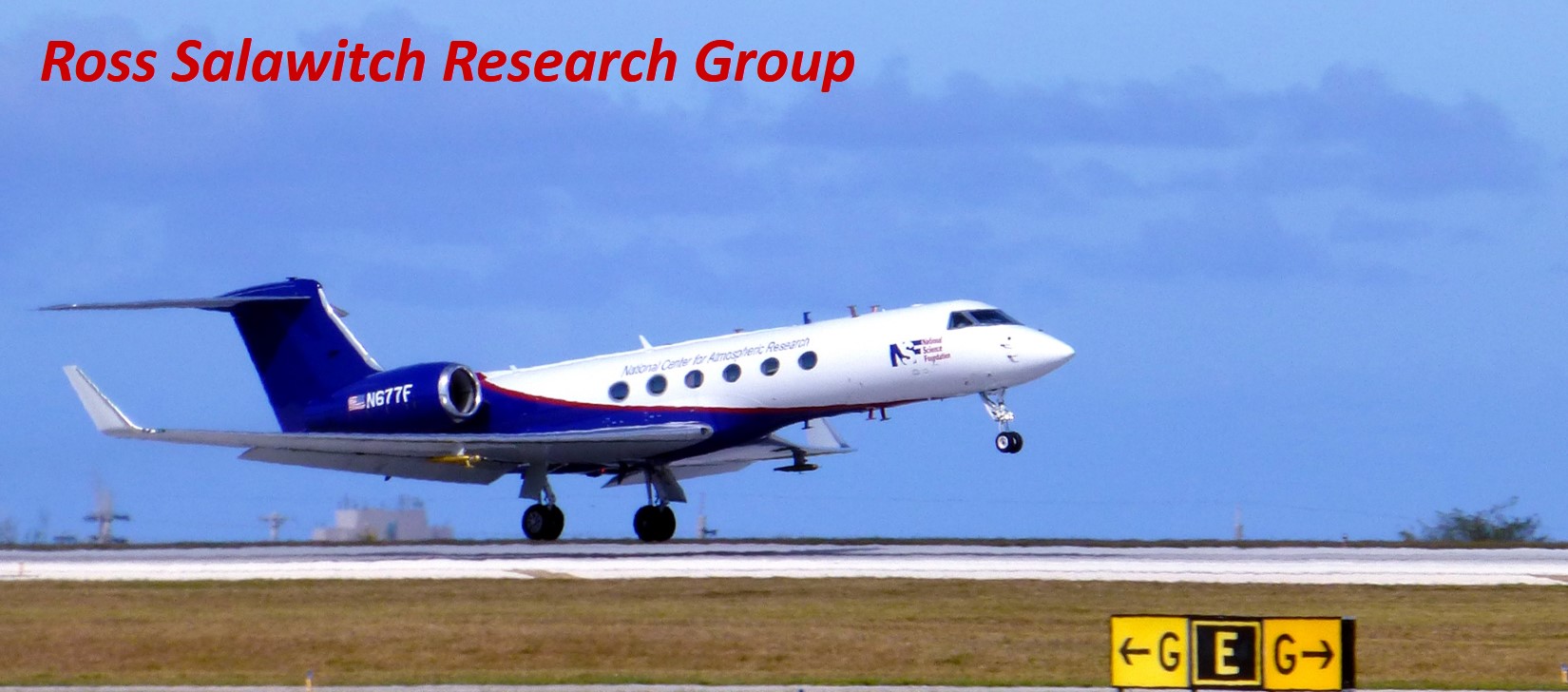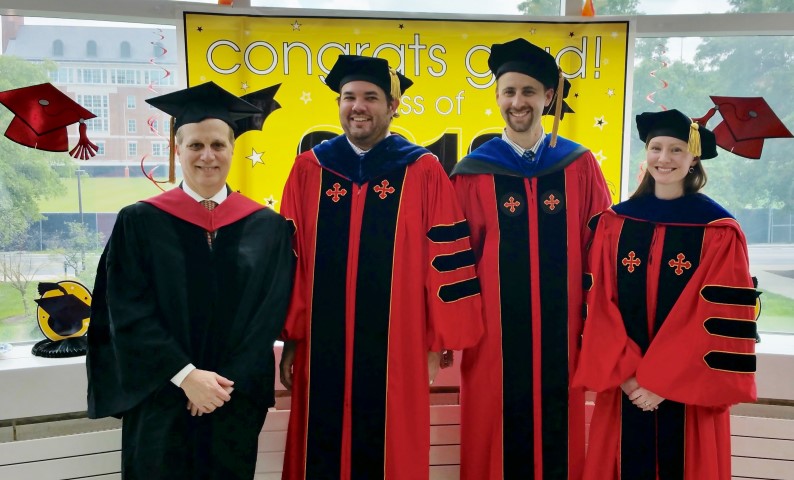
|

NCAR GV
taking off from Guam airport, 19 Jan 2014, for Research Flight 4 of the
NSF CONTRAST field campaign
University of Maryland PhD
Dissertations
The doctoral defense marks an
indelible day in the life of an academic. The
dissertation research is presented in a public seminar; anyone attending
can ask questions. Typically,
following the public presentation, the student meets privately with
their dissertation committee. At this time more questions are
asked. The committee then meets in private and decides whether to
accept the dissertation as submitted, to request changes that can range
from minor to major and may or may not require a re-evaluation of the
document, etc. More often than not, the student is deemed to be a
"Doctor of Philosophy (PhD)" at this meeting, and is greeted as "Dr."
for the first time by their committee. Following this meeting,
most students get to return to a normal sleep cycle for the first time
in many months, then are left to grapple with the question "what next?".

Dr Anderson, Dr Goldberg, Dr Nicely, and one proud adviser.
Below is a
list of the doctoral dissertation defense committees on which I have
served. When available, a link to the slides
presented at the defense has been provided. Also, I've done my
best to provide either a current link for each graduate, or a
researcher ID page that shows the present
affiliation of the UMD alum.
As of
most recent update, I've served on 19 doctoral defense committees,
which averages to 2 per year
(or 1 per semester) since my start at UMD in September 2007.
Of course, some years have more dissertations than others. The gap
in 2013 and 2014 was due to the need to focus on the logistics of
the CONTRAST mission
followed by initial analysis of collected data. And, I've
served on a handful of other committees as the so-called Dean's
Representative. I've only listed those for which I
served on the actual, academic committee.
Each dissertation is
about 180 pages; 19
×
180 = 3420 pages. Prior to the defense, each
page of every dissertation has been read (welcome to email any of the folks below for confirmation).
It's been a pleasure to be able to read these dissertations, each of
which describes an advancement of the state of knowledge
in the fields of either atmospheric chemistry, physics, or climate.
The
Digital Repository of the
University of Maryland (DRUM) provides an easy to access PDF
record of the dissertation for all of the committees on which I have
served. As such, have done my best to use the actual DRUM URL.
2017:
Andrew Jongeward
Identification
and Quantification of Regional Trends and Impact on Clouds Over
the North Atlantic (link to DRUM copy will be posted once
available)
Primary
adviser: Zhanqing Li
2016:
Dan Anderson
Photochemistry and Transport of Tropospheric Ozone and Its
Precursors in Remote and Urban Environments
Co-adviser:
Russ Dickerson
Clare Flynn
Relationship Between Column Density and Surface Mixing Ratio for
O3
and NO2:
Implications for satellite observations and the Impacts of
Vertical Mixing
Primary adviser:
Ken Pickering
Julie Nicely
An Examination of Hydroxyl Radical: Our Current Understanding of
the Oxidative Capacity of the Troposphere Through Empirical,
Box, and Global Modeling Approaches
Galina Wind
Multi-Sensor Cloud and Aerosol Retrieval Simulator and its
Applications
Co-advisers:
Steve Platnick and
Arlindo da Silva
2015:
Dan Goldberg
Lifetime and Distribution of Ozone and Related Pollutants
in the Eastern United States
Primary adviser:
Russ Dickerson
Fang Zhao
Changes in the
Seasonal Amplitude of Atmospheric Carbon Dioxide Concentration:
Causes and Future Projections
Primary adviser:
Ning
Zeng
2012:
David Giles
A Study of Remotely Sensed Aerosols Properties from Ground-based Sun
and Sky Scanning Radiometers
Primary
advisers: Russ Dickerson
and
Anne Thompson
Hao He
Air Pollutant Concentrations and Trends over the Eastern U.S. and China:
Aircraft Measurements and Numerical Simulations
Primary
adviser:
Russ Dickerson
Haohao Ke
Advanced
Receptor Models for Exploiting Highly Time Resolved Data
Acquired in the EPA Supersite Project
Primary
adviser:
John Ondov
Matus Martini
Tropospheric Ozone and Its Radiative Effects due to
Anthropogenic and Lightning Emissions: Global and Regional
Modeling
Primary
advisers: Dale Allen and
Ken Pickering
Julie Wolf
The Effects of Future Global
Change on Arbuscular Mycorrhizal Fungi and Soil Carbon: Using
Urbanization as a Surrogate for Future Conditions in Field
Studies
Primary
adviser:
Brian Needelman
2011:
Elena Yegorova
An Evaluation
of a Severe Smog Episode in the Eastern U.S. using Regional Modeling and
Satellite Measurements
Primary
advisers: Dale Allen and
Russ Dickerson
Steven Greybush
Mars Weather and Predictability:
Modeling and Ensemble Data Assimilation of Spacecraft Observations
Primary adviser:
Eugenia Kalnay
2010:
Dan Barrie
On the
Interaction of Wind Energy with Climate and Energy
Click here to see Dan's
PhD defense presentation
Primary
adviser: Dan Kirk-Davidoff
Ninghai Sun
Retrieval
of Ice Cloud Parameters Using DMSP Special Sensor Microwave
Imagers/Sounder (SSMIS)
Primary
advisers:
Fuzhong Weng and
Zhanqing Li
2009:
Ji-Sun Kang
Carbon
Cycle Data Assimilation Using A Coupled Atmosphere-Vegetation Model and
the Local Kalman Filter
Click here to see
Ji-Sung's PhD defense presentation
Primary
adviser: Eugenia Kalnay
2008:
Bryan Bloomer
Air
Pollution Response to Changing Weather and Power Plant Emissions In the
Eastern United States
Click
here to see Bryan's PhD defense presentation
Primary
adviser: Russ
Dickerson
Can Li
Emissions, Transport, and Evolution of Atmospheric Pollution from China:
An Observational Study
Click
here to see Can's PhD defense presentation
Primary
advisers: Russ
Dickerson and
Zhanqing Li
_____
University of Maryland Undergraduate
Gemstone Dissertation
The UMD
Gemstone
program is a four-year program of research, culminating in a
dissertation, for undergraduate honors students. Freshman
participate in a Gemstone orientation prior to the start of their
freshman year. During February of the freshman year, faculty
present students with possible research topics. Students form
research teams and conduct research on the selected topic, during the
rest of their ~3.5 years on campus. Current
Gemstone teams are posted at
link.
During
their senior year, the Gemstone teams make a public presentation of their team's
dissertation findings to a panel of "discussants", who have also
received a draft copy of the dissertation document. The room is
filled with family members, classmates and friends, as well as freshman
Gemstone students who are being exposed to the end product of many
year's hard work and creative thinking of the senior Gemstone Research
Team. Following the student presentations, discussants ask a
single question, then anyone in the audience is invited to ask
questions. Once the public discussion has ended, the Gemstone
Research Team meets privately with their faculty adviser and the
discussants. Of course, a celebration typically follows this last
meeting.
In 2010, I
had the privilege of serving as a discussant for the dissertation
submitted by the
"Carbon Sink" Gemstone Research Team.
The 14
members of this research team used field
research, a set of laboratory experiments, and computer modeling to
quantify the effectiveness of carbon sequestration by burial of dead
trees, as a means to offset rising levels of atmospheric CO2
due to the burning of fossil fuels. The research of team Carbon
Sinks was supervised by Professor
Ning Zeng of UMd AOSC and Jay Gregg, a
research assistant with the Joint Global Change Research Institute.
The dissertation submitted by Team Carbon Sinks was comparable to a PhD
dissertation!
_____
My Doctoral Dissertation
Alas, my
doctoral dissertation, entitled Antarctic Ozone: Theory and
Observation was completed in 1988, prior to the advent of PDF
files! According to the great and irrefutable resource called
Google, Adobe Acrobat was the first software program capable of
reading the PDF format ... and Version 1 of Adobe Acrobat launched
in June 1993. As such, my dissertation is archived only via
microfiche at places such as
link1 or
link2.
Trust me,
it is not worth the time, effort, or $$$ to obtain a copy of my
doctoral dissertation. All that is important was published in the
peer-reviewed literature long ago. Archives of my dissertation still exist, albeit in a now archaic
format. It is fascinating that we live in a time when our means of communicating
information is changing so rapidly.
Should anyone actually want to see my doctoral dissertation, stop by my office and I'll gladly show you
the bound edition.
The
important lesson of the above two paragraphs, one I do my best to
impart upon my students, is that few people will ever read a
doctoral dissertation. Basically, the committee and a handful
of students to either follow in the same research group or perhaps working on a similar topic in another group, constitute the
very limited audience of a document that ostensibly plays such an
important role in the life of a scholar.
However,
many people will read the peer reviewed articles that result from a
doctoral dissertation. As such, getting scientific results
into the peer reviewed literature is the most important
part of a graduate education so that:
a)
findings are communicated in a manner that has transitioned, and
almost certainly will continue to transition, with developments
in the means of communication (all of my papers are accessible
in the form of PDF files; journals have much stronger motivation
and better resources to make this transition than universities,
even those of high standing with large endowments);
b)
the student learns the ins and outs, idiosyncrasies, struggles,
frustrations, and ultimately (hopefully) joy of publishing.
Yes, we have been known to shed a tear of joy upon receipt of an
email from an editor stating a paper has been accepted.
For an academic, a day when such an email has been received can
rarely be topped ... other than, of course, getting an email
stating a grant proposal has been accepted!
Only
fitting to conclude by providing the link to our group's
publication page.
|
|
Department
of Atmospheric and Oceanic Science
College of Computer, Mathematical, and
Natural Sciences
Department
of Chemistry and Biochemistry
The University of Maryland
Newsdesk
Earth
System Science Interdisciplinary Center
The University of Maryland |



